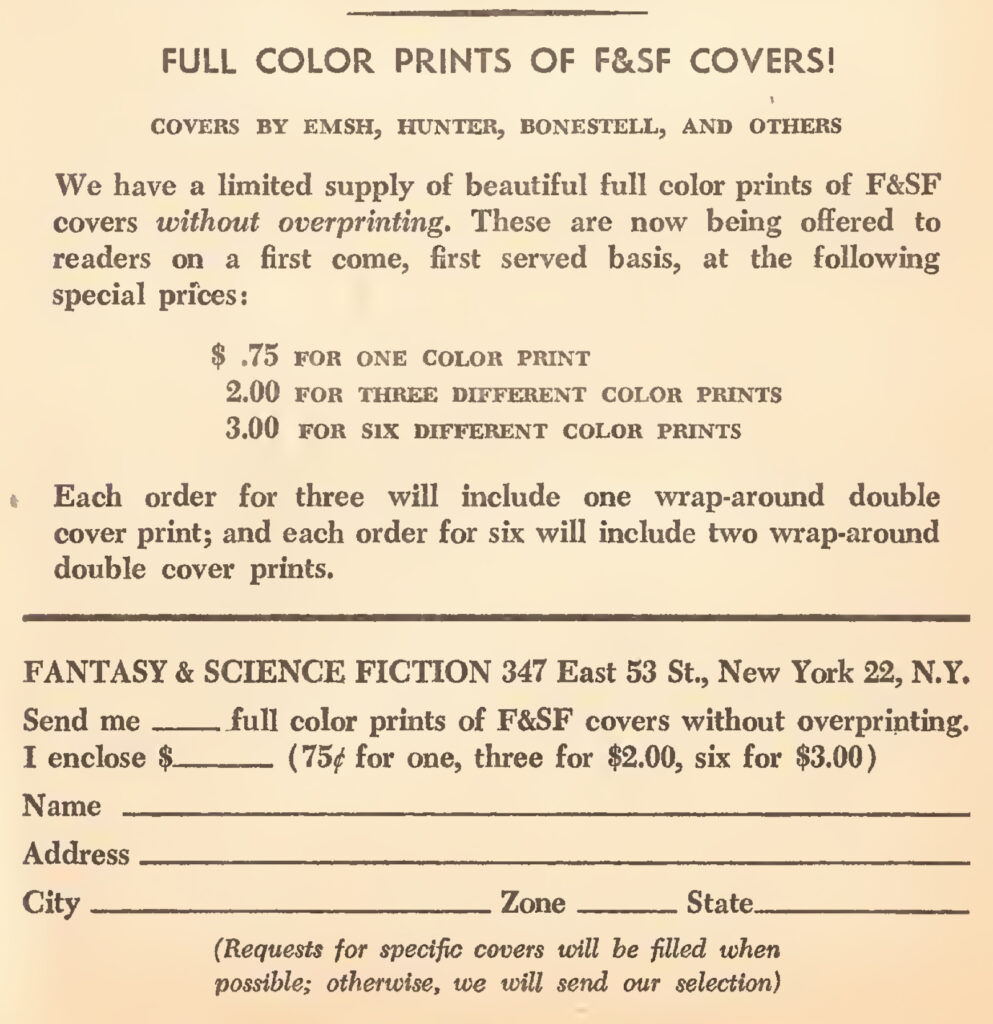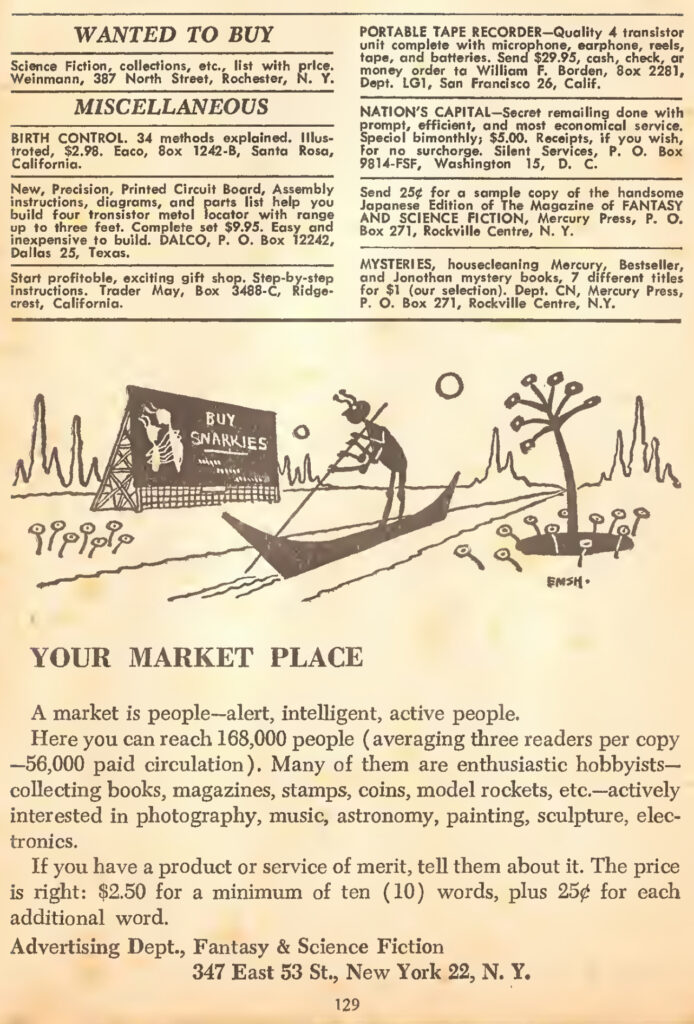In my ceaseless quest to avoid useful work, I recently opened up an old magazine from my double-stacked shelves of old sf/f zines, this one being the January 1963 issue of The Magazine of Fantasy and Science Fiction.
“This is good,” I said to myself. “I’m very successfully avoiding work. But how can I extend this evasion successfully into the future?”
There being no one else there, I was forced to respond: “I have access to the issues for that whole year, in physical and or electronic form. I could read and write reviews of them all!”
So that’s what this is.

Mack Reynolds’ novella “Speakeasy”
This issue is from a transitional period in F&SF’s already storied career; former editor Robert P. Mills is still credited as “consulting editor” and sf/f giant Avram Davidson is now “Executive Editor”, but already credited as “Managing Editor” is Edward Ferman, who would go on to be editor and publisher of the magazine though, arguably, its greatest period.
Davidson, a wordy man with a distinctively baroque style and a delight in the absurd, seems to be the dominant voice in the editorial “we”. In most magazines, editorial blurbs before stories and magazines run to a few lines; in this issue they’re frequently more than a page. Davidson is never boring, though, so I’m not complaining.
The features are pretty sparse compared to later years. There’s no movie/TV column, for instance. In 1963, there wasn’t enough good sf/f onscreen to make a monthly column worthwhile; it would have mostly been recaps of Twilight Zone episodes six months after they aired. But the books column was a regular feature from the magazine’s first issue, and by 1963 Asimov was already in place as the regular science-fact columnist. There’s a one-page editorial at the very back of the book where Davidson amuses himself by making mock of a letter-to-the-editor he’d received.
The books column is of thin interest at this point, more than 62 years after this magazine hit the stands. Davidson himself wrote the reviews: regarding Judith Merril’s seventh “Best of” collection; the paperback of August Derleth’s posthumous collabroation with H.P. Lovecraft, The Survivor and Others (Ballantine, 1962); and a minor fantasy by J.B. Priestley that Davidson damns with faint praise. The Derleth book he damns with loud mockery. Davidson was one of those sf/f people who have little patience with or interest in Lovecraftian horror. Since I’m also one of those people, I found his comments funny, if somewhat mean-spirited. The most interesting thing in the column was mention of a collaboration between Paul Dehn, who was the scenarist of Goldfinger, The Spy Who Came in From the Cold, The Deadly Affair, Escape from the Planet of the Apes and its sequels, etc, and Edward Gorey, who was Edward Gorey. Davidson didn’t think much of it, but it might be worth tracking down a copy of the Merril book or its source for this one piece.
Asimov’s science column was about blood types and transfusion. It was informative and interesting, once you get past the mugging Asimov usually does at the beginning of his articles. One can imagine the young Larry Niven reading this with interest and taking notes.
L. Sprague de Camp contributed a semi-interesting article about the trip he took to gather material for one of his historical novels, The Dragon at the Ishtar Gate. I made a mental note to check out these books. I have made the same note about fifteen thousand times. My reaction to de Camp’s writing is wildly various: sometimes I find it great; sometimes it’s like rubbing sand in my eyes.
There’s a science quiz by Joseph Stacey for people who like science quizzes. The task is to match up element names with little known facts about them. I did find some of the facts interesting, but not so interesting that I remember any of them now.
Randall Garrett contributed a couple of short poem that reminded me of The Space Child’s Mother Goose. That’s fairly high praise coming from me.
A magazine like this stands or falls by the fiction it publishes, though.
The lead story, “The Golden Brick” by P.M. Hubbard, is introduced by Avram Davidson with a magniloquent page and a half blurb in which Davidson suggests that Hubbard is the second coming of M.R. James. I grunted skeptically, read the story, and now this that maybe Davidson was right. I’d never read anything by Hubbard before, but I’ll be looking for more. This is a solid horror-adventure, which went in a different direction than I expected. Also: Everything Is Better With Latin!™ At one point a character says Redde baculum! (“Give back the stick!”) a couple times.
The main event in this issue for me is the Fritz Leiber story, “Myths My Great-Grand-daughter Taught Me”, because it’s a Fritz Leiber story (albeit a minor one) and it’s about myth. I won’t lie to you: I lied to you above. I looked up this issue in the course of my day job as a myth teacher so that I could recommend it to one of my students. But this is an early and pretty successful effort by Leiber to meld sf/f, pyschological fantasy, and myth, something he would do more memorably later on (e.g. “Endfray of the Ofay”, A Specter Is Haunting Texas, “Rime Isle”, etc). The editor steps in the story’s punchline in his blurb, so if you read the tale in this issue, I’d skip the blurb and plunge straight into Leiber’s text.
There is a Ferdinand Feghoot mini-story in this issue. This was an interminable series of gags that ran forever in F&SF. Each one is a shaggy-dog story that sets up a contrived pun in the story’s last line. I like puns, so I don’t mind these, but this is exactly the same thing as all the others, because they are all the same. If you believe everything you read, you will believe that they were written by Grendel Briarton, but don’t do that: they were actually written by Reginald Bretnor.
Henry Slesar contributes “Way-Station”. It’s an okay story about an old man dying who is not exactly old and not exactly a man. I’m more interested in looking up his The Gray Flannel Shroud, which Davidson mentions as winning the Edgar in 1959. Slesar was a well-known pro at the time who wrote a lot for the Alfred Hitchcock TV show and palled around with Harlan Ellison.
Frederik Pohl contributes a story called “Punch”, evidently a reprint from Playboy; it’s copyright 1961 by the HMH Company. But there’s not much of a punch in this watered-down version of “To Serve Man”.
The largest helping of fiction in this issue is Mack Reynolds’ novella “Speakeasy”, which gets a handsome cover paiting from Emsh and an amusing blurb from Davidson, and which completely failed to interest me. It’s set in a technocratic, post-democratic future where speech is strictly policed (by people enforcing social norms and by the ant-democratic government). Given that I’m living in this future, one would think I’d find this story a page-turner, but I found it a chore to get through. It’s always that way with me and Mack Reynolds’ fiction. His wildly imaginative high-concept futures sound fascinating (interstellar spies! literal corporate warfare! American blacks flee racism in the US to liberate colonialized Africa!), but the stories just kind of lie there while people lecture each other.
In this issue I would strongly recommend the Hubbard and the Leiber, and let everything else slide into oblivion.
Nostalgia Department: I was struck by the advertisement for color prints of F&SF covers.

They were still doing this in the early 70s when I started subscribing, so they must have made some decent money this way. Maybe modern magazines (always pressed for cash) could do something similar. I ordered a few sets of these and really liked them, though they have gone the way of all flesh over the past fifty-some years.
I also laughed reading the classified ads at the back of the book.
Who was it that needed secret remailing from “Silent Services”—and how many found themselves paying blackmail afterwards? How useful was that “Birth Control” book with “34 methods explained”? Any classified ad was a window into someone else’s world, sometimes a very strange world. I really missed them when they got devoured by the internet.

